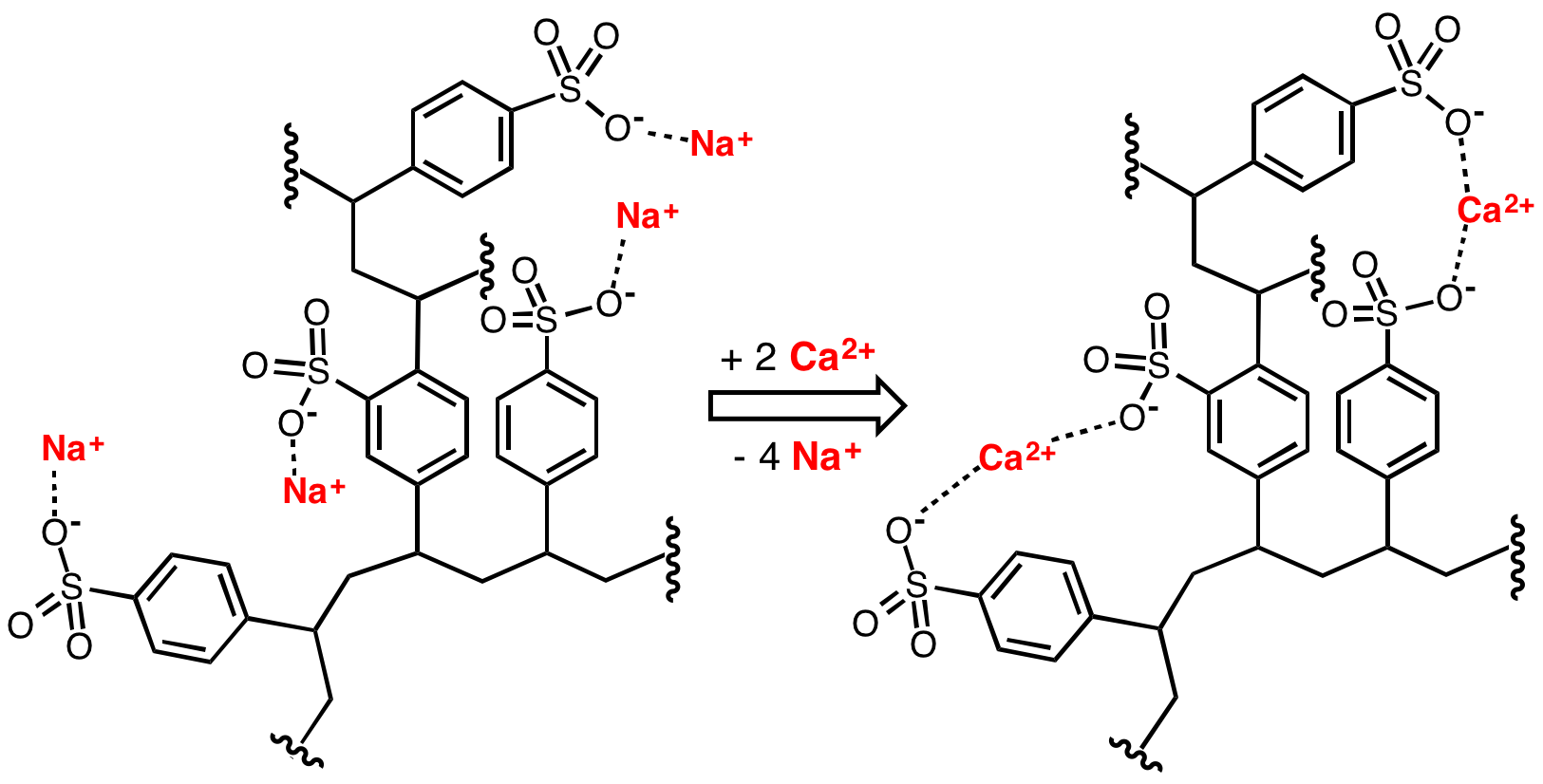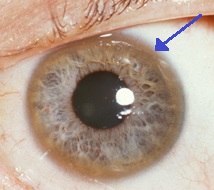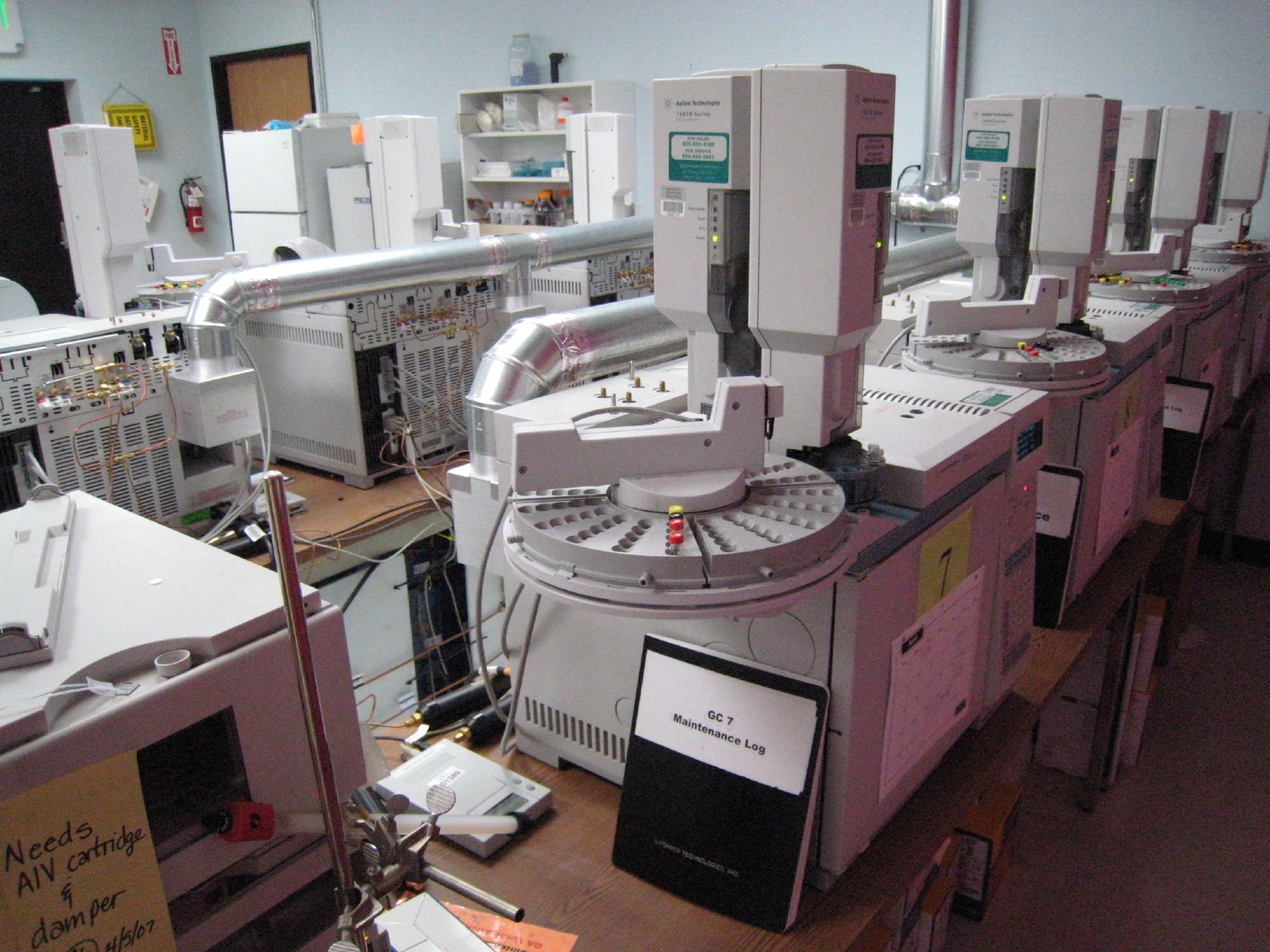|
Chelating Resin
Chelating resins are a class of ion-exchange resins. They are almost always used to bind cations, and utilize chelating agents covalently attached to a polymer matrix. Chelating resins have the same bead form and polymer matrix as usual ion exchangers. Their main use is for pre-concentration of metal ions in a dilute solution. Chelating ion-exchange resins are used for brine decalcification in the chlor-alkali industry, the removal of boron from potable water, and the recovery of precious metals in solutions. Properties and structure Chelating resins operate similarly to ordinary ion-exchange resins. Most chelating resins are polymers (copolymers to be precise) with reactive functional groups that chelate to metal ions. The variation in chelating resins arises from the nature of the chelating agents pendant from the polymer backbone. Dowex chelating resin A-1, also known as Chelex 100, is based on iminodiacetic acid in a styrene-divinylbenzene matrix. Dowex A-1 is available commer ... [...More Info...] [...Related Items...] OR: [Wikipedia] [Google] [Baidu] |
Ion-exchange Resin
An ion-exchange resin or ion-exchange polymer is a resin or polymer that acts as a medium for ion exchange, that is also known as an ionex. It is an insoluble matrix (or support structure) normally in the form of small (0.25–1.43 mm radius) microbeads, usually white or yellowish, fabricated from an organic polymer substrate. The beads are typically porous (with a specific size distribution that will affect its properties), providing a large surface area on and inside them where the trapping of ions occurs along with the accompanying release of other ions, and thus the process is called ion exchange. There are multiple types of ion-exchange resin, that differ in composition if the target is an anion or a cation and are created based on the task they are required for. Most commercial resins are made of polystyrene sulfonateFrançois Dardel and Thomas V. Arden "Ion Exchangers" in Ullmann's Encyclopedia of Industrial Chemistry, 2008, Wiley-VCH, Weinheim. . which is followe ... [...More Info...] [...Related Items...] OR: [Wikipedia] [Google] [Baidu] |
Mida
Mida may refer to: * Mida, Lorestan, a village in Iran * Mida (website), Israeli online magazine * Lucia Mida, a golfer * MIDA, an organic compound * Mida Rana, a character from Yandere Simulator#Characters, ''Yandere Simulator'' * MIDA, (Brand), Motorcycle Helmet and Accessories Brand, British Design. * Mida (plant), ''Mida'' (plant), a genus of Santalaceae * Malaysian Investment Development Authority, the Malaysian governmental agency for manufacturing investment {{disambiguation, geo ... [...More Info...] [...Related Items...] OR: [Wikipedia] [Google] [Baidu] |
Iminodiacetic Acid
Iminodiacetic acid is the organic compound with the formula HN(CH2CO2H)2, often abbreviated to IDA. A white solid, the compound is a dicarboxylic acid amine (the nitrogen atom forms a secondary amino group, not an imino group as the name suggests). IDA is a popular chelating ligand, first introduced in the early 1950s by Schwarzenbach. Ligand The iminodiacetate dianion is typically a tridentate ligand, forming metal complexes by forming two, fused, five membered chelate rings. IDA thus forms stronger complexes than the bidentate ligand glycine and weaker complexes than the tetradentate ligand nitrilotriacetic acid. IDA can also act as a bidentate ligand through its two carboxylate groups. Several technetium-99''m'' complexes with bidentate IDA derivatives are used in cholescintigraphy scans (the so-called "hepatobiliary iminodiacetic acid scans") to evaluate the health and function of the gallbladder. Common IDA derivatives include lidofenin, mebrofenin, and disofenin tha ... [...More Info...] [...Related Items...] OR: [Wikipedia] [Google] [Baidu] |
Thiourea
Thiourea () is an organosulfur compound with the formula and the structure . It is structurally similar to urea (), with the oxygen atom replaced by sulfur atom (as implied by the '' thio-'' prefix). The properties of urea and thiourea differ significantly. Thiourea is a reagent in organic synthesis. Thioureas are a broad class of compounds with the formula Structure and bonding Thiourea is a planar molecule. The C=S bond distance is 1.71 Å. The C-N distances average 1.33 Å. The weakening of the C-S bond by C-N pi-bonding is indicated by the short C=S bond in thiobenzophenone, which is 1.63 Å. Thiourea occurs in two tautomeric forms, of which the thione form predominates in aqueous solutions. The equilibrium constant has been calculated as ''K''eq is . The thiol form, which is also known as an isothiourea, can be encountered in substituted compounds such as isothiouronium salts. : Production The global annual production of thiourea is around 8,000 tonnes, mo ... [...More Info...] [...Related Items...] OR: [Wikipedia] [Google] [Baidu] |
2-Picolylamine
2-Picolylamine is an organic compound with the formula H2NCH2C5H4N. A colorless liquid, it is a common bidentate ligand and a precursor to more complex multidentate ligands such as tris(2-pyridylmethyl)amine. It is usually prepared by hydrogenation of 2-cyanopyridine. One such complex is Baratta's catalyst RuCl2(PPh3)2(ampy) (ampy = 2-picolylamine) for transfer hydrogenation. Salts of the complex e(pyCH2NH2)3sup>2+ exhibit spin crossover behavior, whereby the complex switches from high to low spin configurations, depending on the temperature. Safety The oral in quail Quail is a collective name for several genera of mid-sized birds generally placed in the order Galliformes. The collective noun for a group of quail is a flock, covey, or bevy. Old World quail are placed in the family Phasianidae, and New ... is low, being 750 mg/kg. References {{DEFAULTSORT:Picolylamine, 2- 2-Pyridyl compounds Amines ... [...More Info...] [...Related Items...] OR: [Wikipedia] [Google] [Baidu] |
Maintenance Therapy
Maintenance therapy is a medical therapy that is designed to help a primary treatment succeed. For example, maintenance chemotherapy may be given to people who have a cancer in remission in an attempt to prevent a relapse. This form of treatment is also a common approach for the management of many incurable, chronic diseases such as periodontal disease, Crohn's disease or ulcerative colitis Ulcerative colitis (UC) is one of the two types of inflammatory bowel disease (IBD), with the other type being Crohn's disease. It is a long-term condition that results in inflammation and ulcers of the colon and rectum. The primary sympto .... References External linksMaintenance Therapyfor periodontal diseaseMaintenance Therapyfor intestinal inflammatory diseases Medical treatments Therapy {{treatment-stub ... [...More Info...] [...Related Items...] OR: [Wikipedia] [Google] [Baidu] |
Hereditary Hemochromatosis
Hereditary haemochromatosis type 1 (HFE-related haemochromatosis) is a genetic disorder characterized by excessive intestinal absorption of Human iron metabolism, dietary iron, resulting in a pathological increase in total body iron stores. Humans, like most animals, have no mechanism to regulate excess iron, simply losing a limited amount through various means like sweating or menstruating. Excess iron accumulates in tissues and organs, disrupting their normal function. The most susceptible organs include the liver, heart, pancreas, skin, joints, gonads, thyroid and pituitary gland; patients can present with cirrhosis, polyarthropathy, hypogonadism, heart failure, or diabetes. There are five types of hereditary hemochromatosis: type 1, Juvenile hemochromatosis, 2 (2A, 2B), Haemochromatosis type 3, 3, Haemochromatosis type 4, 4 and 5, all caused by mutated genes. Hereditary hemochromatosis type 1 is the most frequent, and uniquely related to the HFE gene. It is most common among ... [...More Info...] [...Related Items...] OR: [Wikipedia] [Google] [Baidu] |
Iron Overload
Iron overload is the abnormal and increased accumulation of total iron in the body, leading to organ damage. The primary mechanism of organ damage is oxidative stress, as elevated intracellular iron levels increase free radical formation via the Fenton reaction. Iron overload is often ''primary'' (i.e hereditary haemochromatosis, aceruloplasminemia) but may also be ''secondary'' to other causes (i.e. transfusional iron overload). Iron deposition most commonly occurs in the liver, pancreas, skin, heart, and joints. People with iron overload classically present with the triad of liver cirrhosis, secondary diabetes mellitus, and bronze skin. However, due to earlier detection nowadays, symptoms are often limited to general chronic malaise, arthralgia, and hepatomegaly. Signs and symptoms Organs most commonly affected by hemochromatosis include the liver, heart, and endocrine glands. Hemochromatosis may present with the following clinical syndromes: * liver: chronic liver di ... [...More Info...] [...Related Items...] OR: [Wikipedia] [Google] [Baidu] |
Wilson's Disease
Wilson's disease (also called hepatolenticular degeneration) is a genetic disorder characterized by the excess build-up of copper in the body. Symptoms are typically related to the brain and liver. Liver-related symptoms include vomiting, weakness, fluid build-up in the abdomen, swelling of the legs, yellowish skin, and itchiness. Brain-related symptoms include tremors, muscle stiffness, trouble in speaking, personality changes, anxiety, and psychosis. Wilson's disease is caused by a mutation in the Wilson disease protein (''ATP7B'') gene. This protein transports excess copper into bile, where it is excreted in waste products. The condition is autosomal recessive; for people to be affected, they must inherit a mutated copy of the gene from both parents. Diagnosis may be difficult and often involves a combination of blood tests, urine tests, and a liver biopsy. Genetic testing may be used to screen family members of those affected. Wilson's disease is typically tre ... [...More Info...] [...Related Items...] OR: [Wikipedia] [Google] [Baidu] |
Copper Toxicity
Copper toxicity (or Copperiedus) is a type of metal poisoning caused by an excess of copper in the body. Copperiedus could occur from consuming excess copper salts, but most commonly it is the result of the genetic condition Wilson's disease and Menke's disease, which are associated with mismanaged transport and storage of copper ions. Copper is essential to human health as it is a component of many proteins, but hypercupremia (high copper level in the blood) can lead to copper toxicity if it persists and rises high enough. Chronic toxicity by copper is rare. The suggested safe level of copper in drinking water for humans varies depending on the source, but tends to be pegged at 1.3 mg/L. So low is the toxicity of copper that copper(II) sulfate is a routine reagent in undergraduate chemistry laboratories. Signs and symptoms Acute symptoms of copper poisoning by ingestion include vomiting, hematemesis (vomiting of blood), hypotension (low blood pressure), melena (black ... [...More Info...] [...Related Items...] OR: [Wikipedia] [Google] [Baidu] |
Analytical Chemistry
Analytical skill, Analytical chemistry studies and uses instruments and methods to Separation process, separate, identify, and Quantification (science), quantify matter. In practice, separation, identification or quantification may constitute the entire analysis or be combined with another method. Separation isolates analytes. Qualitative inorganic analysis, Qualitative analysis identifies analytes, while Quantitative analysis (chemistry), quantitative analysis determines the numerical amount or concentration. Analytical chemistry consists of classical, wet chemistry, wet chemical methods and modern analytical techniques. Classical qualitative methods use separations such as Precipitation (chemistry), precipitation, Extraction (chemistry), extraction, and distillation. Identification may be based on differences in color, odor, melting point, boiling point, solubility, radioactivity or reactivity. Classical quantitative analysis uses mass or volume changes to quantify amount. Ins ... [...More Info...] [...Related Items...] OR: [Wikipedia] [Google] [Baidu] |



